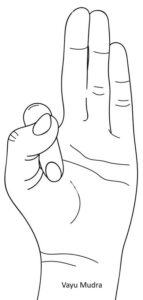Vayu Mudra
Introduction
Vayu Mudra is a yogic hand gesture specifically designed to balance the Vata dosha (air element) in the body according to Ayurvedic principles. It is particularly effective in reducing excess air, alleviating joint pain, calming the nervous system, and improving mental focus.
The term Vayu in Sanskrit means air, highlighting its role in controlling movement, circulation, and nervous energy within the body. This mudra is commonly used in yoga therapy, meditation, and pranayama for its therapeutic benefits.
Meaning
Vayu: Air element, associated with movement, circulation, and nerve function.
Mudra: A hand gesture used to influence pranic flow and physiological balance.
Overall Meaning:
Vayu Mudra is a gesture to reduce excess air, calm restlessness, and restore balance in both body and mind.
How to Perform / Practice
Sit comfortably in a meditative posture (Padmasana, Sukhasana, or on a chair) with a straight spine.
Bring the tips of both index fingers to the base of their respective thumbs, then press your thumbs down onto the top knuckles of the index fingers.
Close your eyes, breathe slowly and evenly, and focus on balancing air energy in the body.
Practice for 15–30 minutes daily, or in shorter intervals of 5–10 minutes.
Tip: Best practiced morning or evening, or whenever feeling restless, anxious, or gassy.
Benefits
Physical Benefits:
Reduces excess Vata, alleviating bloating, gas, and digestive discomfort.
Improves joint lubrication and reduces stiffness.
Supports proper circulation and nervous system function.
Helps relieve tremors or involuntary movements caused by Vata imbalance.
Mental & Emotional Benefits:
Calms restlessness, anxiety, and mental agitation.
Enhances focus, clarity, and emotional stability.
Promotes relaxation and reduces tension in the mind and body.
Energetic / Spiritual Benefits:
Balances Vata energy in the pranic channels.
Supports meditation by fostering a sense of groundedness and mental calm.
Encourages smooth energy flow throughout the body.
Contraindications
Avoid if experiencing hand or finger injuries.
Not recommended for severe arthritis or chronic joint pain in fingers.
Discontinue if numbness, tingling, or discomfort occurs.
Should be practiced moderately in cases of excess Pitta or Kapha, as overdoing can imbalance other doshas.
Anatomy & Physiology
Muscles: Engages intrinsic hand muscles (lumbricals, interossei) to maintain finger flexion.
Joints: Flexion at the index finger; extension at thumb, middle, ring, and little fingers.
Nervous System: Activates parasympathetic pathways to calm overactive neural activity.
Circulation: Improves microcirculation in hands and indirectly supports systemic energy and digestion.
Kinesiology
Enhances fine motor coordination of fingers.
Supports static postural stability during seated meditation or yoga practice.
Encourages a relaxed hand posture, aiding focus and energetic balance.
Neurology
Stimulates brain regions associated with calmness, focus, and motor control.
Balances sympathetic and parasympathetic activity to reduce anxiety and tremors.
Supports neural pathways for attention, emotional regulation, and bodily awareness.
Duration of Practice
Daily Practice: 15–30 minutes, can be split into 2 sessions.
Short Practice: 5–10 minutes whenever Vata imbalance is felt.
Can be combined with Prithvi Mudra or Surya Mudra for enhanced metabolic and energetic benefits.
Counter Mudra
If energy feels sluggish or Vata is excessively reduced, switch to Prithvi Mudra or Shunya Mudra.
Gentle hand stretching or shaking is recommended after long practice.
Conclusion
Vayu Mudra is a powerful hand gesture to balance Vata dosha, calm the nervous system, and alleviate physical and mental restlessness. Regular practice improves digestion, joint flexibility, mental clarity, and emotional stability. Proper execution ensures maximum benefits without discomfort.
FAQ
Q1: Can beginners practice Vayu Mudra?
A: Yes, it is simple and safe; start with 5–10 minutes and gradually increase.
Q2: Can it help with anxiety or nervousness?
A: Yes, it calms the mind and reduces mental agitation.
Q3: Can it be combined with other mudras?
A: Yes, it can be combined with Prithvi Mudra or Surya Mudra for enhanced energy balance.
Q4: Is it suitable during meditation?
A: Yes, it enhances calmness, focus, and emotional stability.
References
Swami Satyananda Saraswati, Mudras for Healing and Transformation.
Iyengar, B.K.S., Light on Yoga.
Saraswati, S., Pranayama and Mudras in Yoga Therapy.
Fishman, L., Yoga for Emotional Balance.
Lad, V., Ayurveda: The Science of Self-Healing.
Journal of Bodywork and Movement Therapies, 2018; 22(4): Effects of Hand Mudras on Mental and Physiological Functions.

